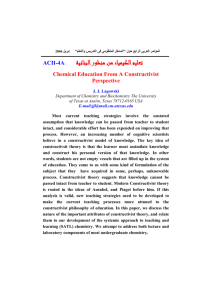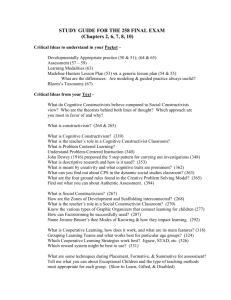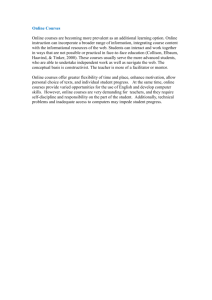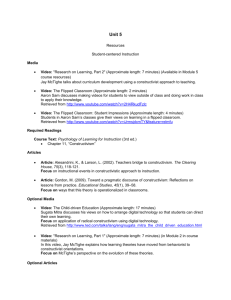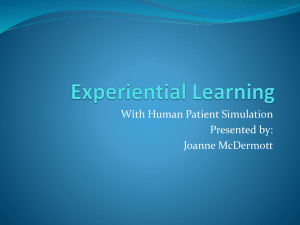Constructivism and Library Instruction - N. Renee Brown's E
advertisement
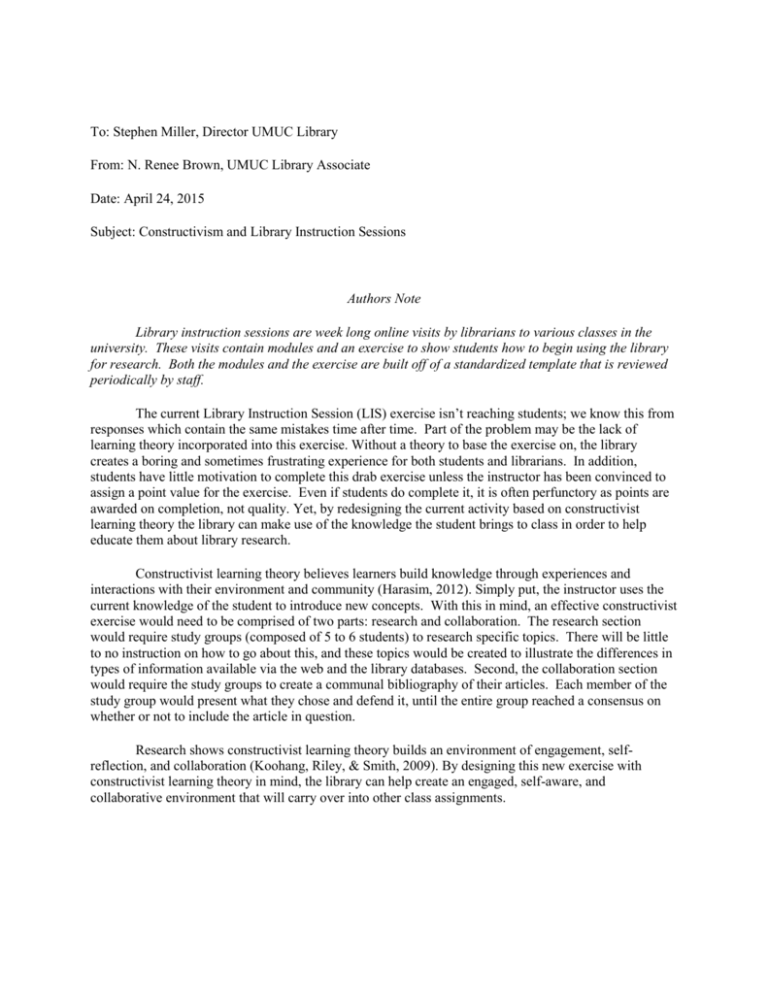
To: Stephen Miller, Director UMUC Library From: N. Renee Brown, UMUC Library Associate Date: April 24, 2015 Subject: Constructivism and Library Instruction Sessions Authors Note Library instruction sessions are week long online visits by librarians to various classes in the university. These visits contain modules and an exercise to show students how to begin using the library for research. Both the modules and the exercise are built off of a standardized template that is reviewed periodically by staff. The current Library Instruction Session (LIS) exercise isn’t reaching students; we know this from responses which contain the same mistakes time after time. Part of the problem may be the lack of learning theory incorporated into this exercise. Without a theory to base the exercise on, the library creates a boring and sometimes frustrating experience for both students and librarians. In addition, students have little motivation to complete this drab exercise unless the instructor has been convinced to assign a point value for the exercise. Even if students do complete it, it is often perfunctory as points are awarded on completion, not quality. Yet, by redesigning the current activity based on constructivist learning theory the library can make use of the knowledge the student brings to class in order to help educate them about library research. Constructivist learning theory believes learners build knowledge through experiences and interactions with their environment and community (Harasim, 2012). Simply put, the instructor uses the current knowledge of the student to introduce new concepts. With this in mind, an effective constructivist exercise would need to be comprised of two parts: research and collaboration. The research section would require study groups (composed of 5 to 6 students) to research specific topics. There will be little to no instruction on how to go about this, and these topics would be created to illustrate the differences in types of information available via the web and the library databases. Second, the collaboration section would require the study groups to create a communal bibliography of their articles. Each member of the study group would present what they chose and defend it, until the entire group reached a consensus on whether or not to include the article in question. Research shows constructivist learning theory builds an environment of engagement, selfreflection, and collaboration (Koohang, Riley, & Smith, 2009). By designing this new exercise with constructivist learning theory in mind, the library can help create an engaged, self-aware, and collaborative environment that will carry over into other class assignments. Engagement Two of the largest contributors to online student dropout are isolation and detachment (Bolliger & Inan, 2012). Students struggle to find a connection in an online world that is faceless and voiceless, yet studies show that student connectedness can be attained via learning communities and collaborative work, leading to a much more engaged classroom overall (Robinson, & Hullinger, 2008). Thus, constructivism eases this sense of isolation by creating an arena of active learning where students participate and act rather than passively receiving knowledge (Harasim, 2012). A library exercise based in this theory can encourage students to become an active participant in their own learning by creating a problem for them to solve (in this case a research question), and then encouraging discussion on why they chose to solve it the way they did. This active learning exercise not only engages the student, but creates a sense of community within the classroom as they discuss the solution. Personal Knowledge/Self-Reflection Today’s students are often digital natives with a certain level of web-based research experience. Yet, the library exercise, as it is set up now, does not respect or use that in any way. Instead, librarians take the research process out of the hands of the student, leaving them frustrated and dependent upon the librarian (Elmborg, 2002). Often students feel punished for going online to find articles, and are warned away the net so often that when they could benefit from it they are afraid to use it. Instead, envision a library exercise which uses student’s personal knowledge helps to build new research strategies. If the library uses the tools students are comfortable with, such as Google, the learning activity can lead students from what they know, into library research easily and naturally (Humrickhouse, 2011). The entire process makes more sense and is less daunting when coming from a place the student is familiar with. Collaboration Collaboration has been called the key to creating a community of learning online (Robinson, & Hullinger, 2008). Robinson and Hullinger (2008) also found that collaboration empowers and encourages students to such an extent that it impacts future learning experiences. Thus, including collaborative work in the library exercise, and encouraging a sharing of knowledge among peers should be paramount. By requiring a collaborative project to be presented in the class, the library exercise can contribute to future learning, not only by instilling information literacy tenants but by increasing student confidence as well. Collaborative learning also helps the librarians by focusing on a group projects instead of preparing individual responses. This allows the librarian to focus on guiding the groups. The emphasis here would be on guidance, as librarians have a tendency to answer questions instead of allowing those questions to help the student take control of the project and make discoveries on their own (Elmborg, 2002). This guidance will likely be much less intensive than the responses currently posted in response to every student exercise and take less time. Pilot Program The library could easily create a pilot program comparing the constructivist exercise to the current library instruction exercise in two sections of the same class. At the end of the pilot a comparison of levels and types of participation will be made. In addition, there will be an evaluation of the completeness/correctness of the group bibliography. Finally, the library can solicit both student and instructor feedback via a survey. This survey will ask them to evaluate the experience as a whole. If the constructivist exercise is more successful than the one currently in place, the library could consider implementing it. References Bolliger, D., & Inan, F. A. (2012). Development and validation of the Online Student Connectedness Survey (OSCS). The International Review of Research in Open and Distributed Learning, 13(3). Retrieved from http://www.irrodl.org/ Harasim, L. (2012). Learning Theory and Online Technologies. New York, NY: Routledge. Humrickhouse, E. (2011). Information literacy instruction in the Web 2.0 library. Retrieved from http://eric.ed.gov/ Koohang, A., Riley, L., Smith, T., & Schreurs, J. (2009). E-learning and constructivism: From theory to application. Interdisciplinary Journal of E-Learning & Learning Objects, 591-109. Retrieved from http://informingscience.org/ Robinson, C. C., & Hullinger, H. (2008). New benchmarks in higher education: Student engagement in online learning. Journal of Education for Business, 84(2), 101-109. Retrieved from http://www.tandfonline.com/toc/vjeb20/current#



